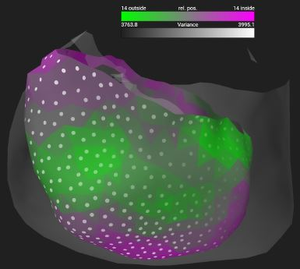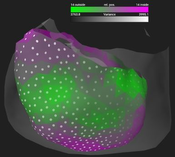Information
- Publication Type: Master Thesis
- Workgroup(s)/Project(s):
- Date: March 2018
- Date (Start): 1. April 2017
- Date (End): 4. March 2018
- TU Wien Library:
- First Supervisor:
- Keywords: comparative visualization, statistical shape analysis
Abstract
Automatic segmentation of pelvic organs plays a major role in prostate cancer treatment and has high accuracy requirements. Segmentation experts are continuously working on improving their algorithms. However, natural anatomical variability of organs and structures is a common reason for which segmentation algorithms fail. Understanding why an algorithm fails in a specific case is of major importance. Segmentation experts expect that the shape and size of the organs can play an important role in the performance of their algorithms, but current means of exploration and analysis are limited and do not provide the necessary insight. This thesis discusses the design and implementation of a web-based application allowing for easy exploration and analysis of shape variability in order to generate hypotheses about the relation between algorithm performance and shape of organs. A new way of comparatively visualizing multiple organs of multiple patients is introduced for a detailed shape comparison. The application was tested with segmentation meshes of a cohort of 17 patients, each consisting of four pelvic organs and two organ-interfaces, which are labeled and have per-triangle correspondence. The proposed tools already allow users to quickly identify mis-segmented organs and hypothesize about the relation of variability to anatomical features as well as segmentation quality. The approach was applied on pelvic organ segmentations, but it can be extended to other applications like comparison of segmentation algorithms or analysis of anatomical variability in general.Additional Files and Images
Weblinks
BibTeX
@mastersthesis{Reiter2017CVAP,
title = "Comparative Visualization of Pelvic Organ Segmentations",
author = "Oliver Reiter",
year = "2018",
abstract = "Automatic segmentation of pelvic organs plays a major role
in prostate cancer treatment and has high accuracy
requirements. Segmentation experts are continuously working
on improving their algorithms. However, natural anatomical
variability of organs and structures is a common reason for
which segmentation algorithms fail. Understanding why an
algorithm fails in a specific case is of major importance.
Segmentation experts expect that the shape and size of the
organs can play an important role in the performance of
their algorithms, but current means of exploration and
analysis are limited and do not provide the necessary
insight. This thesis discusses the design and implementation
of a web-based application allowing for easy exploration and
analysis of shape variability in order to generate
hypotheses about the relation between algorithm performance
and shape of organs. A new way of comparatively visualizing
multiple organs of multiple patients is introduced for a
detailed shape comparison. The application was tested with
segmentation meshes of a cohort of 17 patients, each
consisting of four pelvic organs and two organ-interfaces,
which are labeled and have per-triangle correspondence. The
proposed tools already allow users to quickly identify
mis-segmented organs and hypothesize about the relation of
variability to anatomical features as well as segmentation
quality. The approach was applied on pelvic organ
segmentations, but it can be extended to other applications
like comparison of segmentation algorithms or analysis of
anatomical variability in general.",
month = mar,
address = "Favoritenstrasse 9-11/E193-02, A-1040 Vienna, Austria",
school = "Institute of Computer Graphics and Algorithms, Vienna
University of Technology ",
keywords = "comparative visualization, statistical shape analysis",
URL = "https://www.cg.tuwien.ac.at/research/publications/2018/Reiter2017CVAP/",
}

 image
image Master Thesis
Master Thesis

